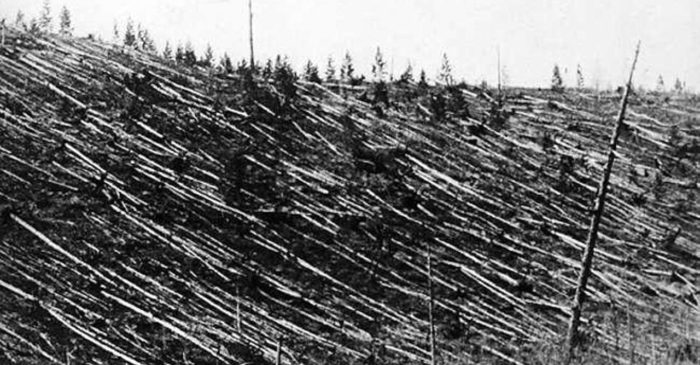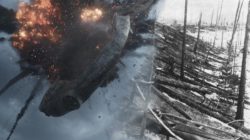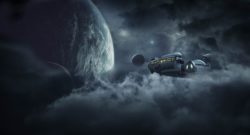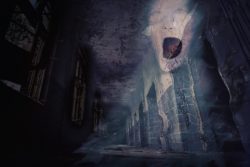
There Was An Explosion Over Tunguska, But It Wasn’t A Meteorite!
- By
- January 26, 2017
- September 27, 2021
- 5 min read
- Expert Opinion
- 2
- Posted in
- Conspiracy Theory Analysis, Historical
At least those are the controversial theories of Alexander Kasantsev, Professor Felix Zigel, and many other scientists over the years. Their theories have since expanded through numerous conspiracy theorists around the globe, perhaps for good reason.
The incident of 1908 is arguably the biggest cataclysmic event ever witnessed by modern humans. Essentially, what occurred was of “biblical” proportions. A lucky escape then that the meteor happened to explode before it made an impact. Even luckier perhaps, that the region itself was very remotely inhabited, lest the death toll might have been huge.

Tunguska flattened trees.
To some though, the location was not a coincidence at all. Its selection was very purposeful and intended – exactly so as to avoid such a disaster and loss of life.
Contents
The Tunguska Incident
A huge explosion rocked the skies over Siberia shortly after 7 am on 30th June 1908. The impact site was somewhere in the dense woodland surrounding the Tunguska River. Very few people called the area home, but witnesses from great distances were immediately aware that something had happened.
One farmer, Sergei Semenov, who lived forty miles away, claimed while sitting on his porch a sudden flash of light exploded. He then felt a blast of heat so hot that he had to go back inside his home. He further stated that a “huge ball of fire” covered the sky. A shock wave from the blast knocked him to the floor where he lost consciousness.
Towns that were over two-hundred miles away could also clearly see a “pillar of fire” from the region. Residents in areas over three-hundred miles away reported “gusts of wind” so strong that it made windows shake. In Irkutsk, over five-hundred miles from the blast, tremors normally associated with large earthquakes registered. Even as far away as the United Kingdom, meteorological stations recorded violent shock waves from the North Sea.
In all, when scientists the world over compared their findings and recordings of unusual activity following the blast, they found that shock waves had circled the planet twice, such was their power.
Check out the short video below which looks at the basics of the incident, and has some haunting pictures of the scene.
The Aftermath
The aftermath of the explosion did leave an area roughly four times the size of Great Britain in complete ruin. The ground looked as if great chunks of earth had rearranged themselves. Elsewhere trees looked shredded and some even ripped from their roots. In 1928 Russian scientist, Leonid Kulik led an expedition to the area. In his report to the Soviet Academy of Science, he wrote, “……the whole area bears evidence of an immense catastrophe!”
Most of the theories mainly revolved around the notion that a meteorite had struck the Earth somewhere over the Tunguska River. Kulik himself subscribed to this theory and fully expected to discover a large crater where the meteor had impacted. When he didn’t see evidence of this, he had to conclude that “no evidence presents itself” that a meteorite had struck the Earth.
His findings ultimately led to the theory that the meteorite had exploded above the Earth’s surface. However, the first seeds of doubt to the idea that a natural body was responsible were taking hold.
Check out the video below which looks at interesting facts concerning the event.
A Nuclear Explosion?
The leading theories, and official version of events was that a meteorite exploded around twenty miles from the ground. That was until the dropping of the Atomic bombs on the Japanese cities of Nagasaki and Hiroshima in 1945. When writer, Alexander Kasantsev, witnessed the aftermath of those history-changing events, his mind crashed back to the devastation of Tunguska.
More and more, he was beginning to see the similarities between the two scenes. So much so, that he believed that the explosion that occurred over the region, was a nuclear one. The vastly increased radiation levels present for miles around the site also suggested this be the case.
He claimed the havoc left behind was also not consistent with accepted theories, again drawing comparisons to the ruins of Nagasaki and Hiroshima.
Given the remoteness of the location, Kasantsev ruled out an “intentional” strike. He came to the conclusion that an intelligently guided craft, powered by nuclear energy, had attempted to land that morning. It had, however, exploded before it reached the ground.
As much as Kasantsev believed his theory to be correct, he also firmly believed that others wouldn’t. In fact, the story is that he considered his theory so controversial he “hid” it within the plot of a science-fiction story.
The short video below looks at such claims that Tunguska is very much a UFO incident.
Theories “Hidden” In Fiction?
Essentially, Kasantsev believed that an “interstellar” craft – powered by nuclear energy – came into difficulties and located Earth as a place to attempt an emergency landing. They entered Earth’s atmosphere, aiming for a location where they could land their craft. Inevitably though, the fault appeared to have caused the ship to explode in mid-air.
By the 1960s, other scientists drew similar comparisons to the atomic bomb sites in Japan. It’s widely agreed that the size of the blast was thirty times larger than either of those sites. In 1966 Russian scientists, V.K. Zhuravlev, D.V. Demin, and L.N. Demina presented their evidence following an in-depth study. They concluded the Tunguska event was, without doubt, a nuclear explosion.
It wasn’t until Professor Felix Zigel and geologist Alexi Zolotov [1] began their investigation of the case, however, that a theory almost identical to Kasantsev’s “work of fiction” developed.
When they examined the area again, they determined the site of the blast to be a triangular shape. Tiny metal properties also came to light in the soil around the area. This led Zolotov to claim that the “explosive material” was in a non-explosive shell or container when it exploded. Essentially, the material was nuclear, and it was powering a triangular shaped spacecraft.
When Zigel spoke to witnesses, several of them claimed the “fireball” had changed direction in the sky. One witness even claimed to have seen it do this several times. Zigel and Zolotov’s conclusion was that an “artificial construction” that likely weighed over fifty tons, was “being directed towards a landing when it exploded!”
Ultimately, the vast majority of people rejected such notions and their theories dismissed.
The video below looks more in depth at possible UFO involvement over Tunguska.
Supportive Evidence And New Discoveries
There is some supportive evidence to suggest that what exploded over Tunguska was not a natural body falling to Earth.
On the night in question, the Polish Tatranska observatory recorded a “fireball” falling from the sky which changed direction. Dr. Zigel took several witness statements that claimed the same thing.
Another point of interest was the devastation of the trees – or more to the point, the lack thereof. Only one side of the trees that faced the center of the explosion had burn marks. This suggests an intense, short burst of heat – which does happen in nuclear explosions. If the meteorite had exploded as conventional thinking says, the result would likely be a raging forest fire.
In August 2004 the head of an expedition to the affected region, Yuri Lavbin, stated that debris from an extra-terrestrial device was in their possession from the site. His theory states that a meteorite did indeed head for the Earth that night in 1908. However, an alien spacecraft had intentionally obliterated the threat.
In all probability, there will always be a little bit of “doubt” about the meteorite theory over the Tunguska River. And on the other side of the coin, any solid evidence to prove otherwise will likely also slip away to the passage of time.
The documentary below looks at the event in a lot more detail.
Expert Opinion
Often cited as the largest modern cataclysm in recorded history, the Tunguska event was a colossal explosion in remote Siberia that flattened miles of forest in 1908. Mainstream science usually attributes the devastation to an exploding meteor or comet fragment. Yet, researchers like Alexander Kasantsev and Professor Felix Zigel have proposed unconventional scenarios involving nuclear-like energy or misfiring extraterrestrial technology.
Critics point out the absence of indisputable physical remnants to support theories beyond a cosmic airburst, and stress that meteor explosions can create blast waves and scorched woodlands with no obvious crater. Conversely, claims of sharp directional changes, raised radiation, and UFO traces continue to intrigue investigators. Without conclusive evidence, the site remains a cornerstone of modern mystery, sparking spirited scientific and fringe debate.
The meteor theory is widely accepted, but ambiguous data and peculiar eyewitness reports keep alternative ideas alive.
Marcus Lowth is an expert on this topic and has over 20 years experience studying and reporting in these fields. Marcus has written several books and appeared on TV shows as an expert investigator discussing these topics.
References
| ↑1 | The Tunguska Event, Nigel Watson recalls a mysterious explosion that occurred in deepest Siberia in June 1908, Nigel Watson, History Today, July 7th, 2008 https://www.historytoday.com/archive/tunguska-event |
|---|
Fact Checking/Disclaimer
The stories, accounts, and discussions in this article may go against currently accepted science and common beliefs. The details included in the article are based on the reports, accounts and documentation available as provided by witnesses and publications - sources/references are published above.
We do not aim to prove nor disprove any of the theories, cases, or reports. You should read this article with an open mind and come to a conclusion yourself. Our motto always is, "you make up your own mind". Read more about how we fact-check content here.
Copyright & Republishing Policy
The entire article and the contents within are published by, wholly-owned and copyright of UFO Insight. The author does not own the rights to this content.
You may republish short quotes from this article with a reference back to the original UFO Insight article here as the source. You may not republish the article in its entirety.






2 Comments
UFO Insight does not take responsibility for the content of the comments below. We take care of filtering profanity as much as we can. The opinions and discussion in the comments below are not the views of UFO Insight, they are the views of the individual posting the comment.
Newest comments appear first, oldest at the bottom. Post a new comment!
Hi Snowy – this is an error in the wording and should refer to the radius of the aftershock etc. We will fix this shortly.
Great Britain is 94,058 mi²; the area blasted by the Tunguska event was only 770², nowhere near “four times the size of Great Britain.”